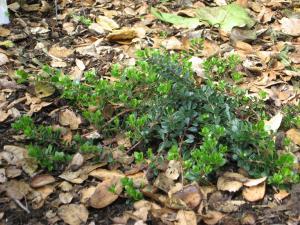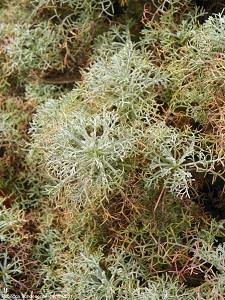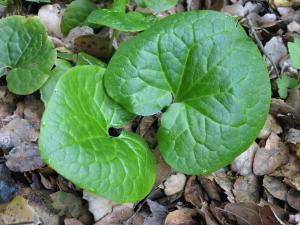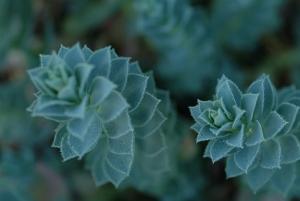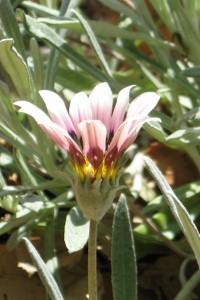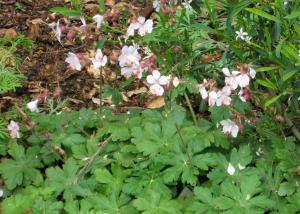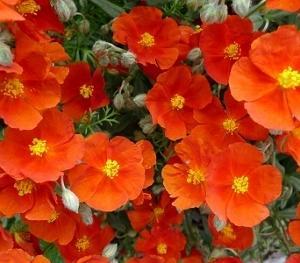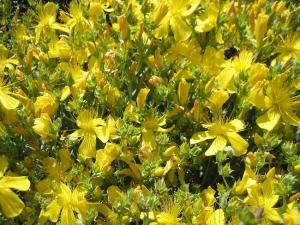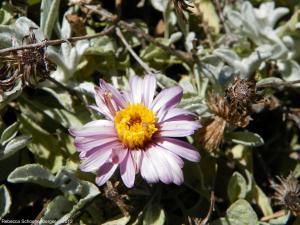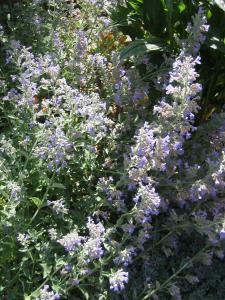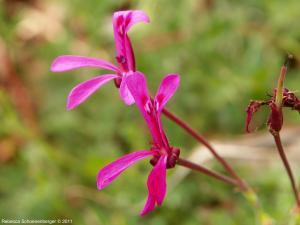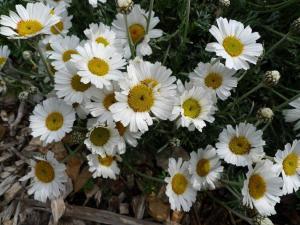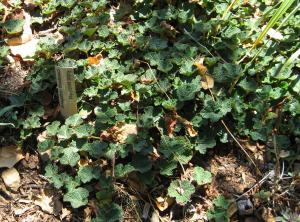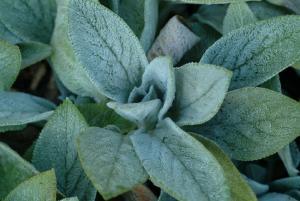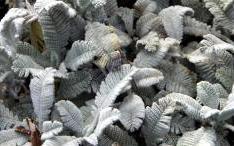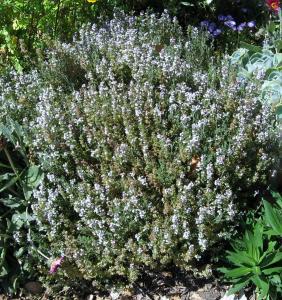Water Wise Plants
Here's a full list of all our water wise plants. You can also view an image gallery, or view the plants by categories.
Anemopsis californica
Pronunciation
an-uh-MOP-sis kal-i-FOR-ni-kuh
Common Name
Yerba Mansa
Plant Type
Groundcover
Mature Size
2 wide x 0.33 - 1 ft(0.1 - 0.3 m) tall
Water Requirements
Moderate: water weekly until the root ball is wet
Sun/Shade Requirements
Full to half sun
Wildlife
Flower Color
White, Cream, Red
Where to See
Maintenance- Design- Planting Tips
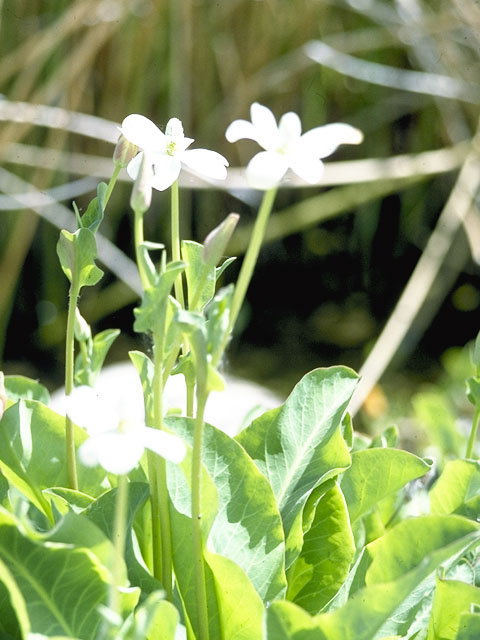
|
Arctostaphylos ‘Emerald Carpet’
Pronunciation
ark-toe-STAF-il-lohs
Common Name
Manzanita ‘Emerald Carpet’
Plant Type
Groundcover
Mature Size
5 ft. wide and 8-14 in. tall
Water Requirements
Low: water every three weeks until the root ball is wet
Sun/Shade Requirements
Full to half sun
Wildlife
Flower Color
Pink flowers
Where to See
Maintenance- Design- Planting Tips
‘Emerald Carpet’ is a slow growing California native manzanita from the coast of Mendocino County. It is a very attractive plant with dark glossy leaves, reddish stems and small flowers in the early spring. There are many different cultivars of manzanita, ranging from ground covers to small trees. Manzanitas are a good wildlife plant and typically are a hearty plant. They do well in very dry situations. Most manzanitas need superb drainage, or they will struggle and die. Plant on a mound or slope and water weekly for the first summer and less after that. By the third summer, stop watering. Avoid fertilizing the plant. These plants rarely need pruning. Remove the odd branch that dies back in the late summer and the plant will fill in. Some gardeners will remove the lower branches on some of the larger manzanitas to highlight the interesting branching structure and reddish bark. Some Santa Clara Master Gardeners have had success using the cultivar ‘Carmel Sur’ as a ground cover in low-water landscapes. PADG notes: ‘Emerald Carpet’ has not thrived at PADG. It may need more water than most manzanitas. |
Artemisia versicolor ‘Seafoam’
Pronunciation
ar-te-MIZ-ee-uh VER-suh-kuh-lor
Common Name
Artemisia versicolor ‘Seafoam’
Plant Type
Groundcover
Mature Size
6 - 12 in. high can spread 15 - 18 in.
Water Requirements
Low: water every three weeks until the root ball is wet
Sun/Shade Requirements
Full to half sun
Wildlife
Flower Color
Yellow and orange
Where to See
Maintenance- Design- Planting Tips
The leaves of Artemisia ‘Seafoam’ are silver and frilly, which add a nice texture to the garden. It is a short-lived perennial that needs to be replanted after several years. The plant wants to bloom, but unfortunately will die back afterwards. To prevent the die back, cut off the yellow flowers.
PADG notes: ‘Seafoam’ has been used as a small edging plant in the Demonstration Garden. We have repeated silver foliage plants around the edge of the garden beds as a way of tying different beds together. But we find cutting off the flowers to keep the plant looking good to be labor intensive. |
Asarum caudatum
Pronunciation
ah-SAR-um kaw-DAH-tum
Common Name
Wild Ginger
Plant Type
Groundcover
Mature Size
7-10 inches high and spreading
Water Requirements
Low: water every three weeks until the root ball is wet
Sun/Shade Requirements
Shade
Wildlife
Flower Color
Maroon, generally hidden by leaves
Where to See
Maintenance- Design- Planting Tips
This California native boasts large, shiny, heart-shaped leaves that give the plant a lush, almost tropical look. The leaves can be up to seven inches wide, which can hide the interesting maroon flowers that bloom in late winter or early spring. Asarum caudatum grows naturally in the coastal redwood forests and prefers a cool, moist environment. In Santa Clara County gardens with coastal influences, wild ginger can do well on a low water diet if given a shady spot and rich soil full of organic material. In drier landscapes, it may disappear in the summer months and reappear after the winter rains. This plant is extremely low maintenance. All it seems to need is the occasional removal of old leaves. |
Euphorbia myrsinites
Pronunciation
yew-FOR-bee-ah mur-zin-EYE-teez
Common Name
Creeping Spurge
Plant Type
Groundcover
Mature Size
6 - 12 in. tall and 12 in. wide
Water Requirements
Low: water every three weeks until the root ball is wet
Sun/Shade Requirements
Full to half sun
Wildlife
Flower Color
Yellow
Where to See
Maintenance- Design- Planting Tips
With its eye catching texture and showy flowers in the spring, Euphorbia myrsinites makes an attractive ground cover for dry areas. These plants will reseed vigorously if not deadheaded, so be sure to cut off the flowering stalks before seeds develop. Leave new growth intact since that will be next spring's flowers.
Take care when cutting Euphorbias because the milky sap can be very irritating to the skin. |
Gazania
Pronunciation
gay-ZAY-nee-uh
Common Name
Gazania
Plant Type
Groundcover
Mature Size
6 in. tall and 12 in. wide
Water Requirements
Low: water every three weeks until the root ball is wet
Sun/Shade Requirements
Full sun
Wildlife
Flower Color
Yellow, orange, white, and pink
Where to See
Maintenance- Design- Planting Tips
Gazanias are colorful, easy to grow, low water plants. Gazanias do better with only occasional water because they can become leggy if given regular water. Cultivars with silver foliage blend particularly well with other Mediterranean plants. Tired blooms can be deadheaded although it is not necessary. If a clump of plants becomes too crowded or too large, divide the plant during the cool season.
PADG notes: Gazanias have been planted along the edges of the Demonstration Garden to help tie together different beds. |
Geranium x cantabrigiense ‘Biokovo’
Pronunciation
ji-RAY-nee-uhm kan-tuh-brij-ee-EN-see
Common Name
Cranesbill ‘Biokovo’
Plant Type
Groundcover
Mature Size
6 - 8 in. tall and spreading
Water Requirements
Low: water every three weeks until the root ball is wet
Sun/Shade Requirements
Full to half sun, shade
Wildlife
Flower Color
Pale pink
Where to See
Maintenance- Design- Planting Tips
This pretty ground cover is good for dry shady areas. The pale pink flowers have a long season and complement a variety of plants, from roses to California native shrubs to coast live oaks. It's easy to propagate and transplant to new areas. Just cut off a small piece, plant it directly in the soil and keep it wet until the plant roots. Shear in the fall to get fresh growth in the spring.
Be aware that geranium ‘Biokovo’ can become aggressive and spread quickly if planted in soil that is fertilized and watered regularly. |
Helianthemum nummularium ‘Henfield Brilliant’
Pronunciation
hee-lee-AN-them-um num-ew-LAH-ree-um
Common Name
Sunrose
Plant Type
Groundcover
Mature Size
6 in. to 12 in. high and 18 in. to 3 ft. wide
Water Requirements
Low: water every three weeks until the root ball is wet
Sun/Shade Requirements
Full to half sun
Wildlife
Flower Color
Orange-red
Where to See
Maintenance- Design- Planting Tips
A low-growing, trailing ground cover from Turkey, Helianthemum is covered with small flowers in the spring. There are many cultivars with different flower colors — red, apricot, yellow, pink, and white. ‘Henfield Brilliant’ is a striking form with its silvery leaves and orange flowers.
Helianthemum likes full sun and well-draining soil with low to moderate water. Shear off the dead flowers to encourage repeat blooms. |
Hypericum reptans
Pronunciation
hy-PARE-ih-kum REP-tanz
Common Name
St. Johnswort
Plant Type
Groundcover
Mature Size
2 in. tall and 1 1/2 in. wide
Water Requirements
Low: water every three weeks until the root ball is wet
Sun/Shade Requirements
Full to half sun
Wildlife
Flower Color
Bright yellow
Where to See
Maintenance- Design- Planting Tips
Hypericum reptans, or ground cover St. Johns’s Wort, is ideal for dry sunny and partially shady areas. This ground cover looks and behaves differently from other species of St. John’s Wort. It has very small leaves and flowers, grows close to the ground and spreads slowly, with yellow flowers appearing in the summer.
Spent flowers can be sheared off when the plant is done blooming. It is easy to start new plants by planting cuttings directly into the soil when the weather has cooled. |
Lessingia filaginifolia
Pronunciation
les-IN-jee-a fi-la-jin-i-FOL-ee-a
Common Name
California Dune Aster
Plant Type
Groundcover
Mature Size
3+ ft. wide and 4 in. tall
Water Requirements
Very Low: water deeply several times a summer
Sun/Shade Requirements
Full to half sun
Wildlife
Flower Color
Pink to lilac
Where to See
Maintenance- Design- Planting Tips
Lessingia felaginifolia is a drought tolerant California native groundcover and a favorite with butterflies. Lessingia ‘Silver Carpet’ is a selection known for its dense, silvery foliage. The short, ground-hugging foliage is only 4 inches high, spreading 3 or more feet. Water deeply a few times over the summer.
|
Nepeta x faassenii
Pronunciation
NEP-eh-tah ex. fah-SEEN-ee-eye
Common Name
Catmint
Plant Type
Groundcover
Mature Size
1 ft. tall and 1 1/2 - 2 ft. wide
Water Requirements
Low: water every three weeks until the root ball is wet
Sun/Shade Requirements
Full to half sun
Wildlife
Flower Color
Lavender-blue
Where to See
Maintenance- Design- Planting Tips
Catmint is a reliable and easy edging plant for low water perennial borders. It has lovely soft gray leaves and lavender-blue flowers in the spring.
After the first set of blooms finishes, catmint should be cut back several inches to keep it from getting leggy and encourage another set of blooms. This is a fun job because the leaves have a wonderful smell. Be aware that some cats also love the smell of the plant and will roll their bodies in the plant and flatten it. PADG Notes: Catmint was one of the earliest plants in the Demonstration Garden providing much needed color the first summer. It is used extensively to visually tie the beds together.
|
Pelargonium ionidiflorum
Pronunciation
pe-lar-GO-nee-um eye-oh-nid-ih-FLOR-um
Common Name
Celery Scented Pelargonium
Plant Type
Groundcover
Mature Size
12 - 18 in. high and 15 -24 in. wide
Water Requirements
Low: water every three weeks until the root ball is wet
Sun/Shade Requirements
Half sun to shade
Wildlife
Flower Color
Magenta pink
Where to See
Maintenance- Design- Planting Tips
Pelargonium ionidiflorum blooms throughout the year with bright pink flowers. Attractive when grown in front of border plants, it stays low and compact and seems to do well in partial shade. Unlike other Pelargoniums, this plant does not get leggy. Maintenance is minimal, and occasional deadheading is all that is needed.
|
Rhodanthemum hosmariense
Pronunciation
rowd-AN-theh-mum hos-mar-ee-EN-see
Common Name
Moroccan Daisy
Plant Type
Groundcover
Mature Size
2 ft. wide and 8 ins. tall
Water Requirements
Low: water every three weeks until the root ball is wet
Sun/Shade Requirements
Full sun
Wildlife
Flower Color
White daisies
Where to See
Maintenance- Design- Planting Tips
Rhodanthemum hosmariense has silver foliage and white daisy flowers. This plant is a good choice as an edging plant. This plant flowers profusely in the winter when not much is in bloom.
Don't over-water this plant or it will rot. It can survive on very little water. Maintenance consists of occasional deadheading of spent flowers. |
Rubus pentalobus
Pronunciation
ROO-bus pen-tuh-LOH-bus
Common Name
Creeping Raspberry
Plant Type
Groundcover
Mature Size
6 ft. wide and 6 in. to 12 in. tall
Water Requirements
Low: water every three weeks until the root ball is wet
Sun/Shade Requirements
Half sun to shade
Wildlife
Flower Color
Small white flowers
Where to See
Maintenance- Design- Planting Tips
|
Solidago velutina
Pronunciation
so-lid-AH-goh vel-ew-TEEN-uh
Common Name
Threenerve Goldenrod
Plant Type
Groundcover
Mature Size
0.7 - 3 ft (0.21 - 0.9 m) tall
Water Requirements
Low: water every three weeks until the root ball is wet
Sun/Shade Requirements
Full sun
Wildlife
Flower Color
Yellow
Where to See
Maintenance- Design- Planting Tips
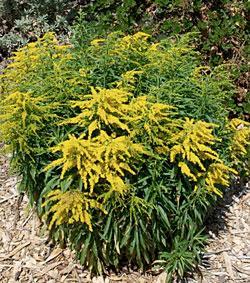
|
Solidago velutina ssp. californica
Pronunciation
so-lid-AH-goh vel-oo-TEE-nuh
Common Name
California Goldenrod
Plant Type
Groundcover
Mature Size
1.5 - 5 ft (0.46 - 1.5 m) tall
Water Requirements
Low: water every three weeks until the root ball is wet
Sun/Shade Requirements
Full to half sun
Wildlife
Flower Color
Yellow
Where to See
Maintenance- Design- Planting Tips
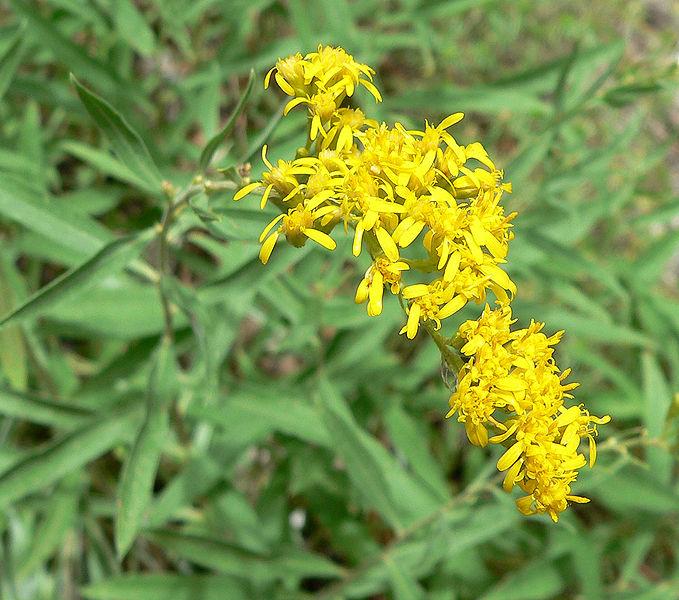
|
Stachys byzantina 'Countess Helen von Stein'
Pronunciation
STAKA-is bye-zan-TEEN-ah
Common Name
Lamb's Ears
Plant Type
Groundcover
Mature Size
3 ft. wide and 6 in. to 12 in. tall
Water Requirements
Low: water every three weeks until the root ball is wet
Sun/Shade Requirements
Full to half sun
Wildlife
Flower Color
Where to See
Maintenance- Design- Planting Tips
Not every plant in the garden has that "wow factor" going for it, and that's a good thing. Sometimes plants are needed to fill in bare spots and give the eye a rest. Lamb's ears are a classic filler plant for a water-wise garden.
"Helen von Stein' is a wonderful cultivar because it has extra-large leaves and doesn't bloom a lot. With its large leaves, it provides contrast to smaller leaved plants in the garden. After a couple years, these plants tend to spread and die out in the middle. Use a sharp shovel and divide the clumps in fall or early winter. Lamb's ears may also have some die back over the winter; we recommend leaving the dead leaves in place until all danger of frost has passed. PADG Notes: We have used Stachys and other silver-leaved plants to visually tie together the edges of our beds. Some gardeners love the dramatic flower spikes on lamb's ears, but we have mixed feelings. Sometimes we cut them off and sometimes we leave them in place.
|
Tanacetum densum amani
Pronunciation
TAN-uh-SEE-tum DEN-sum AHM-an-eye
Common Name
Partridge Feather
Plant Type
Groundcover
Mature Size
6 - 8 in. high, spreading slowly to make a mat about 1 1/2 ft. wide
Water Requirements
Moderate: water weekly until the root ball is wet
Sun/Shade Requirements
Full to half sun
Wildlife
Flower Color
Yellow
Where to See
Maintenance- Design- Planting Tips
Tanacetum densum amani is a ground cover that is native to Turkey. Its leaves are silver and have a feathery texture.
PADG Notes: This plant is used as an edger in one of our beds. One drawback to the plant is the small yellow flowers that appear in late spring. Some people like them, but we cut them off. This plant has survived, but not thrived at in the Palo Alto Demonstration Garden. One reason might be that it likes more water than it receives. It is watered deeply every three weeks. We suspect this plant would look lusher in the summer with deep weekly watering. This plant is not easy to find in nurseries and gardens, but if you like the texture, Tanacetum densum amani is worth seeking out. |
Thymus vulgaris
Pronunciation
TY-mus vul-GAR-iss
Common Name
Thyme
Plant Type
Groundcover
Mature Size
3 in. high and 3 ft. wide
Water Requirements
Low: water every three weeks until the root ball is wet
Sun/Shade Requirements
Full to half sun
Wildlife
Flower Color
Where to See
Maintenance- Design- Planting Tips
Many herbs, including thyme, are great additions to water wise gardens. They can be used in cooking; they smell great and their foliage and flowers are attractive.
Thyme makes a nice ground cover for small spaces. It has grey-green leaves and small white flowers. PADG Notes: To keep thyme neat, the faded flowers are sheared back in early spring. Many thymes are not long lived, but Thymus vulgaris has proven to be long-lived in our water wise garden. |







